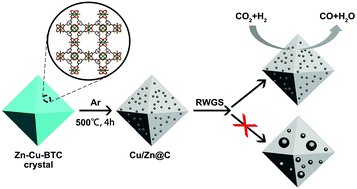当前位置:
X-MOL 学术
›
Mater. Chem. Front.
›
论文详情
Our official English website, www.x-mol.net, welcomes your feedback! (Note: you will need to create a separate account there.)
Pyrolysis of metal–organic frameworks to hierarchical porous Cu/Zn-nanoparticle@carbon materials for efficient CO2 hydrogenation
Materials Chemistry Frontiers ( IF 7 ) Pub Date : 2017-09-11 00:00:00 , DOI: 10.1039/c7qm00328e Jingzheng Zhang 1, 2, 3, 4, 5 , Bing An 1, 2, 3, 4, 5 , Yahui Hong 1, 2, 3, 4, 5 , Yaping Meng 1, 2, 3, 4, 5 , Xuefu Hu 1, 2, 3, 4, 5 , Cheng Wang 1, 2, 3, 4, 5 , Jingdong Lin 1, 2, 3, 4, 5 , Wenbin Lin 1, 2, 3, 4, 5 , Yong Wang 1, 2, 3, 4, 5
Materials Chemistry Frontiers ( IF 7 ) Pub Date : 2017-09-11 00:00:00 , DOI: 10.1039/c7qm00328e Jingzheng Zhang 1, 2, 3, 4, 5 , Bing An 1, 2, 3, 4, 5 , Yahui Hong 1, 2, 3, 4, 5 , Yaping Meng 1, 2, 3, 4, 5 , Xuefu Hu 1, 2, 3, 4, 5 , Cheng Wang 1, 2, 3, 4, 5 , Jingdong Lin 1, 2, 3, 4, 5 , Wenbin Lin 1, 2, 3, 4, 5 , Yong Wang 1, 2, 3, 4, 5
Affiliation

|
Conversion of CO2 to CO via hydrogenation, also known as the reverse water-gas shift (RWGS) reaction, is an important chemical process to generate CO as a platform chemical for further conversions. Metallic Cu catalyses the RWGS reaction at a temperature of 500 °C with a high initial turnover frequency, but surface structural reorganization and particle growth at the reaction temperature deleteriously reduce its activity over time. In this work, we synthesized hierarchical structures of porous Cu@C and Cu/Zn@C materials via pyrolysis of Cu-BTC Metal–Organic Frameworks (MOFs) with or without Zn doping. Carbon encapsulation protects the Cu NPs from sintering, leading to stable catalytic activity at 500 °C under which RWGS is favored. Furthermore, the final catalyst pellet size can be controlled by tuning the crystal size of MOF precursors, eliminating the step of forming catalysts for fixed bed reactor applications.
中文翻译:

金属有机框架的热解为多层多孔Cu / Zn-纳米颗粒@碳材料,以实现有效的CO 2加氢
CO转化2到CO通过氢化,也被称为反向水煤气变换(RWGS)反应,是一种重要的化学处理,以产生CO为平台化学用于进一步转化。金属铜在500°C的温度下以较高的初始周转频率催化RWGS反应,但随着时间的推移,表面结构的重组和颗粒在反应温度下的生长会有害地降低其活性。在这项工作中,我们合成了多孔铜的层次结构@ C和铜/锌@ C材质的经由含或不含锌掺杂的Cu-BTC金属有机骨架(MOF)的热解。碳封装保护了铜纳米颗粒免于烧结,从而在500°C下具有稳定的催化活性,在该温度下,RWGS受到青睐。此外,可以通过调节MOF前体的晶体尺寸来控制最终催化剂颗粒的尺寸,省去了形成用于固定床反应器应用的催化剂的步骤。
更新日期:2017-10-26
中文翻译:

金属有机框架的热解为多层多孔Cu / Zn-纳米颗粒@碳材料,以实现有效的CO 2加氢
CO转化2到CO通过氢化,也被称为反向水煤气变换(RWGS)反应,是一种重要的化学处理,以产生CO为平台化学用于进一步转化。金属铜在500°C的温度下以较高的初始周转频率催化RWGS反应,但随着时间的推移,表面结构的重组和颗粒在反应温度下的生长会有害地降低其活性。在这项工作中,我们合成了多孔铜的层次结构@ C和铜/锌@ C材质的经由含或不含锌掺杂的Cu-BTC金属有机骨架(MOF)的热解。碳封装保护了铜纳米颗粒免于烧结,从而在500°C下具有稳定的催化活性,在该温度下,RWGS受到青睐。此外,可以通过调节MOF前体的晶体尺寸来控制最终催化剂颗粒的尺寸,省去了形成用于固定床反应器应用的催化剂的步骤。



























 京公网安备 11010802027423号
京公网安备 11010802027423号